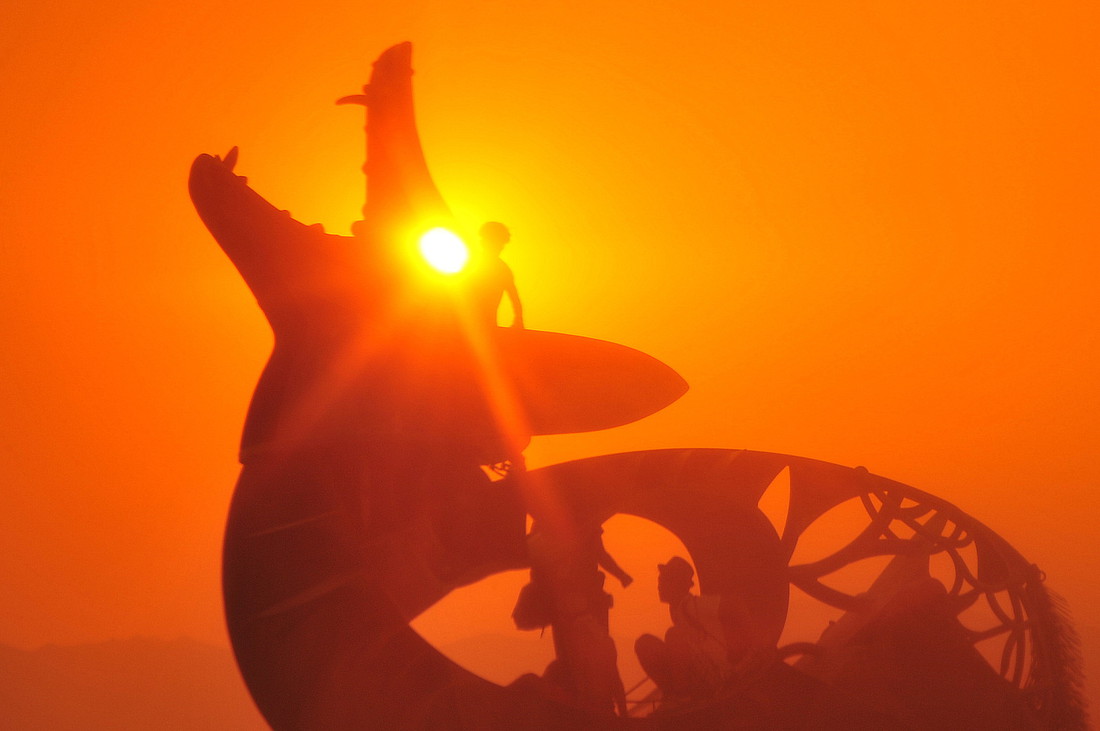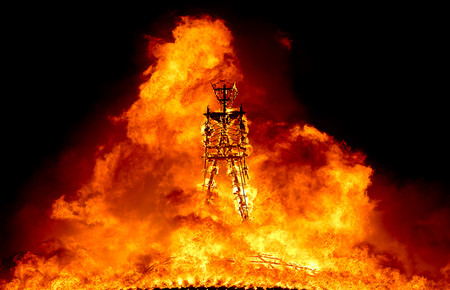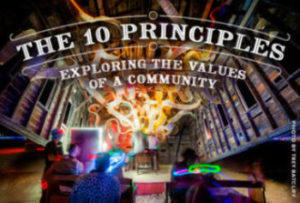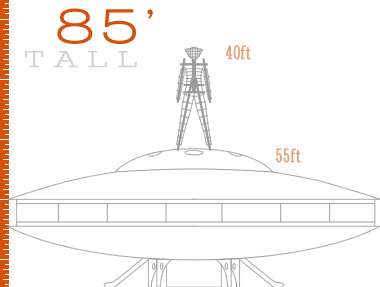
- The Man Base was a massive 117-foot wide, classic 1950s sci-fi flying saucer, featuring three stories connected by intricate stairways.
- Inside the Base was a central core adorned with artwork, exit slides, and elaborate audio compositions and light effects to evoke the interior of your average flying saucer.
- A number of art installations encircled the Man, including five altars intended to allow participants to share offerings with any other visitor to Black Rock City, the YES Project, created by artist Dana Albany and kids from San Francisco
- On the third floor of the Man Pavilion, participants enjoyed installations including RVFMTV2 that displayed a MIDI Synthesizer constructed out of televisions, and Pimpsnaxx that emitted light and sound from its small boxlike structure, acting as an inter-dimensional transportation module.
- A chatty Interactive Robot, known as Rupert, engaged participants in streams of dialogue – sometimes silly, sometimes aggressive, sometimes horny.
- The "Power Kore" sculpture, designed and built by members of the Man Kcrewe, hung in the center of the spaceship.
- "Escape Pods and Zoetropes" inside the Saucer were built by Jack Haye, Mike Hollibaugh, Julie Young, Claus Brigmann, and Jiri Jacknowitz.
- The Man neon was green with yellow outline, feet and ornament.
- Due to the engineering and massive size of the Saucer, 2013's Burn was one of the most impressive on record.
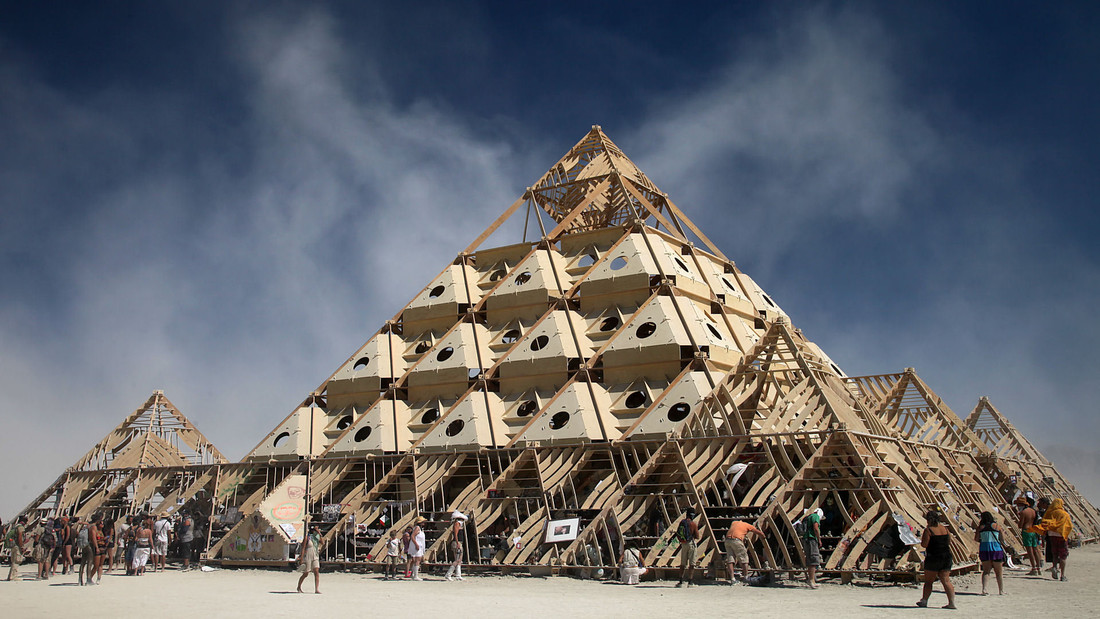
Burning Man held its first ever Black Rock City Drone Summit.
Drone's eye view of Burning Man 2013 - Eddie Codel
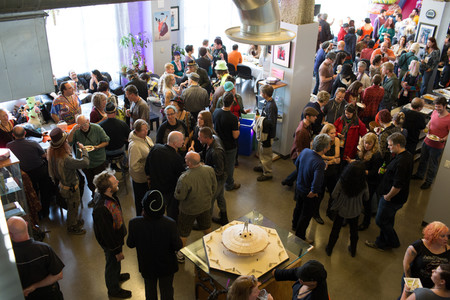
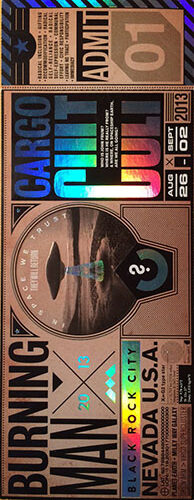
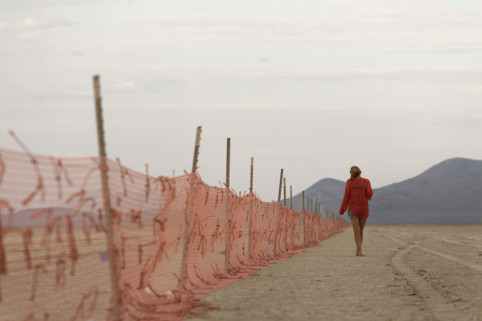
The desert is too hot and it’s too bright and it’s too empty. In the middle of the day, when the light is flat and shadows are nonexistent, the desert is suffocating and relentless. But then … as the afternoon wears away, and as the hills take on color and texture, and as the sky loses its harsh brilliance, the transcendent perfection happens. And the perfectness continues well after sunset, the sky as fabulous a thing as you could ever imagine, and the air as soft as a lover’s whisper.
The desert is never perfect until suddenly, amazingly, it is.
In choosing “Cargo Cult” as the art theme for the 2013 Burning Man event, Larry Harvey made a definitive statement to the Burning Man community: we are the solution we’ve been looking for.
The theme offered a rich tribute to Burning Man’s principles – particularly Radical Self-reliance, Communal Effort, Civic Responsibility and Participation. In the spirit of Cargo Cult, the Man – symbol of our community and its principles – stood atop a massive 50-foot diameter wooden flying saucer in the vintage sci-fi style, as though it had descended from the heavens to save the human race.
In 2013 the so-called “lottery” ticket process from 2012 was abandoned, and replaced with a hybrid of a Directed Group Sale (ensuring tickets got into the hands of key contributors) together with several first-come first-served open sales. And while demand outstripped the ticket supply for the third year in a row, this structure made for a much smoother ticket-buying experience overall.
With a record 69,613 people participating in Black Rock City, there was more of everything – art, theme camps, Mutant Vehicles, bikes, and endless opportunities to engage, connect and participate. And, critically, there were more vehicles traveling to and from the event. Traffic is the biggest threat to Burning Man’s long-term sustainability. To address the issue, the Burner Express shuttle bus system was created to reduce the number of vehicles traveling to and from Black Rock City.. together with carpooling, rideshare boards and shared shipping containers, will be critical to ensure the longevity of the Burning Man event.
On the playa, a number of significant pre-event rainstorms threw a wrench into everybody’s works, but luckily there was wonderful weather throughout the event week. Artists set yet another record with the number of art installations – over 380 incredible pieces graced the open playa, 66 of which were honoraria funded in part by $825,000 in art grants sourced from Burning Man ticket revenues. 24 of these projects were part of the Circle of Regional Effigies (CORE), designed and built by teams from Burning Man’s global Regional Network, placed around the Man… burned simultaneously on Thursday night of the event.
Notable art installations for 2013 included Bryan Tedrick’s “Coyote”, The Flaming Lotus Girls’ “Xylophage”, “Truth is Beauty” by Marco Cochrane, and “BELIEVE” by Laura Kimpton and Jeff Schomburg. First-time Burning Man artists also made a significant impact, including Mike Garlington with his hauntingly beautiful “Photo Chapel”, and the stunning “Church Trap” by Rebekah Waites.
Read more
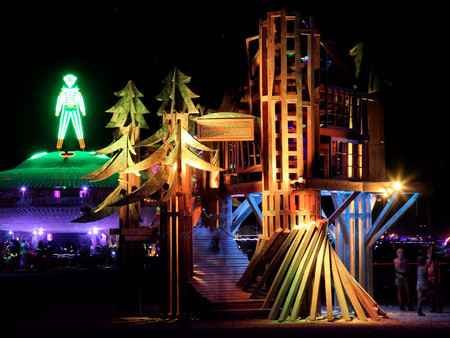
The Circle of Regional Effigies returned to the playa for the third year in a row. This year we redesigned the layout of CORE into four smaller circles of six effigies each. These CORE "neighborhood" circles worked exceptionally well, offering a chance for closer interaction between regional groups from around the globe.
Amongst the 24 effigies there was a great mix first time CORE groups and returning veterans including Idaho, who created Marvin, a wondrous cacophony of light, New York who also returned with a reported 30,000 lights for their effigy. New Orleans also rejoined the CORE effort with Altar of the Wetlands. Some of the first-timers included Israel/Midburn, who offered their piece called Hand of Inspiration and China/Taiwan also joined in with their effigy entitled Enlightenment.
Read more in the AfterBurn Report
- Art theme: Cargo Cult
- Tickets to the Burning Man event sold out for the third year in a row, having reached our maximum population capacity as per BLM event stipulations.
- The Burning Man organization abandoned the ticketing strategy used in 2012, and adopted a combination of Direct Distributed Tickets (ensuring tickets for key contributors) and several first-come first-served open sales.
- A new Event Operations Director was hired, taking over the day-to-day event-related duties of two of Burning Man's founders, and new caretakers were brought on to oversee the Black Rock Station work ranch.
- Burner Express buses provided shuttle services from Reno and San Francisco to and from Black Rock City; over 2000 tickets were sold for this popular new service.
- Ingress traffic into the city and Exodus was a significant challenge, and travel times ranged from 20 minutes to eight hours and more.
- Approximately 40% of Black Rock City's population were first-time Burners.
- After a number of significant pre-event rainstorms, Black Rock City enjoyed wonderful weather throughout the event week.
- Black Rock City streets named after various aspects of the Cargo Cult theme, including Airstrip, Biggie Size, Consumer, Desiderata, Extraterrestrial, False Idol, GDP, Holy, Interstellar, John Frum, Kowtow, and Laissez-faire.
- 844 theme camps and villages were approved for pre-placement in Black Rock City. Art installation support and staff camps bring the placed-camp total for 2013 up to 1056. 76 total camps were denied placement.
- 382 art projects graced the playa, including 66 honoraria projects funded in part by $825,000 in art grants sourced from Burning Man ticket revenues.
- 24 art projects were part of the Circle of Regional Effigies (CORE), created by teams drawn from Burning Man's Regional Network, placed in four clusters of six installations each around the Man, and burned simultaneously on Thursday night of the event.
- Gregg Fleishman, Lightning Clearwater III, Melissa "Syn" Barron and crew created the Temple of Whollyness, a pyramid constructed with interlocking geometric wood pieces, making it the first temple constructed without nails or other metal fasteners. In its center stood a black igneous basalt sculpture in the form of an Inuksuk, which was burned along with the temple.
- The Department of Mutant Vehicles received more applications than ever, and does not increase the total number of vehicles licensed, due to on-playa safety concerns.
- When the Man burned in Black Rock City on Saturday night, the conflagration created was the biggest and hottest Man burn yet, prompting the Fire Art Safety Team to establish the largest burn perimeter around the Man to date.
- Over 132,000 people tuned in to the live webcast on the Saturday of the burn, up from 125,000 in 2012.
- Playa restoration crews grew to their largest size yet, reacting to the increase in BRC population. Black Rock City passed BLM inspection with flying colors.
- Burning Man's waste and recycling crew diverted more recyclables in 2013 than any other year.
- EXTRA (Exodus Trash & Recycling Program) returned for its 7th year, collecting trash 24 hours a day during Exodus week.
- After the 2013 event, Burning Man settled its lawsuit against Pershing County, resulting in a 10-year agreement between event organizers and Pershing County officials designed to cover all of the county's costs and impacts related to the event, while preserving participant activities protected by the First Amendment.
- Over 30 new Regional Contacts joined our ranks in new locations across the world including Brazil, South Korea, Argentina, Austria, Russia, Latvia, Greece, Russia, and Yellowknife (Canada). International interest continues to grow as Burners from Dubai, Mexico, the Yucatan, Columbia, Chile, Turkey, Malaysia and Vietnam have reached out to express their interest in representing Burning Man in their home countries.
- Black Rock City LLC, The Burning Man Project, Black Rock Arts Foundation and Black Rock Solar moved headquarters to San Francisco's Mission District.
- Black Rock City LLC prepared to for the transition wherein it would become part of the non-profit Burning Man Project.
- The 10 Principles blog series was launched, establishing a primary communication channel for the Burning Man Project's Philosophical Center.








































